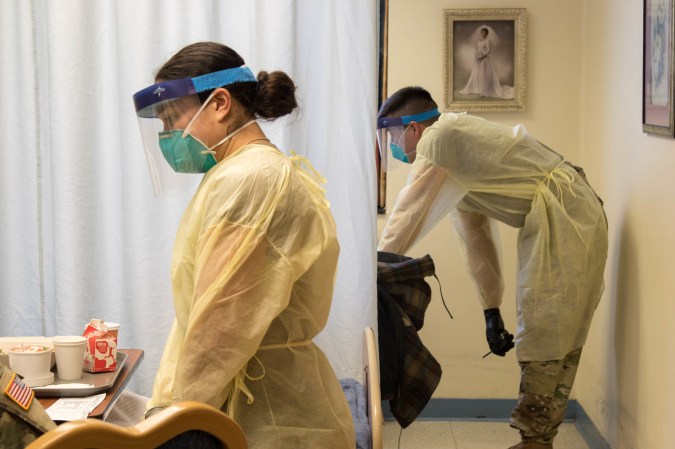

As restrictions on international travel have lifted over the past few months, visitors to the US who were immunized abroad started “doubling up” with another COVID-19 vaccine by a different manufacturer. Some were hoping for more powerful protection from the highly contagious delta variant of the novel coronavirus. Others have moved for work or school and worry about meeting requirements for FDA-approved vaccines.
A few Americans sought out additional doses of the vaccine as well, including ones produced by different manufacturers. And outside the U.S., a handful of countries are moving ahead with second or third doses by different COVID-19 vaccine developers. Now, the FDA has announced that in addition to authorizing booster shots of both the Moderna and Johnson & Johnson vaccines (boosters for Pfizer’s vaccine were authorized last month), the regulatory agency says its now okay to mix and max what booster you get.
Beyond adding a booster for better overall protection against COVID-19, there might be other compelling reasons to mix and match COVID-19 shots, according to some experts. With its authorization this week, which endorsed a mix and max method, the FDA cited a study funded by the National Institutes of Health, which found that mixing and matching was safe and might offer better protection. Scientists are currently exploring how the immune response differs in people who receive one versus two types of immunization. However, the practice could help stretch limited vaccine supplies and may under some circumstances offer superior immune protection.
“The reality is, when you have got so many people vaccinated with half a dozen different types of vaccines out there, the mixing and matching…is probably going to happen,” says Deborah Fuller, a vaccinologist at the University of Washington School of Medicine in Seattle. “It’s probably going to be okay, and it may even be an advantage to see these vaccines actually mixed.”
Have vaccines been mixed and matched before?
Yes, although not always by design.
People sometimes receive doses of both the injectable and oral versions of the polio vaccine, which respectively contain “killed” and weakened versions of the virus, Fuller says. In the United States, it’s also common for people to get different versions of the seasonal flu vaccine from one year to the next.
Deliberately combining different vaccines developed for the same disease is a hot area of research, says Kirsten E. Lyke, director of the Malaria Vaccine and Challenge Unit at the University of Maryland School of Medicine’s Center for Vaccine Development and Global Health in Baltimore.
“It is a tried-and-true approach that we do with vaccine testing all the time, but it hasn’t gotten to primetime, where there is a licensed vaccine combination that intentionally has a mixed platform,” says Lyke, who recently coauthored an editorial in Nature Medicine about mixing COVID-19 vaccines.
Scientists who study vaccines and immunology have previously investigated the technique—which goes by the technical term heterologous prime-boost—for ebola, tuberculosis, and other infectious diseases. Many teams of researchers, including Fuller and her colleagues, have been studying the effects of intentionally mixing different kinds of HIV vaccine candidates for decades. One pairing, not studied by Fuller’s team, lowered the rate of infection by 31 percent in clinical trials. Scientists viewed even this modest degree of protection against such a wily virus as an important milestone.
So far, Fuller says, previous studies on combining vaccines developed for other infectious diseases haven’t uncovered any safety issues. Still, more research is needed to confirm that this holds true for COVID-19 vaccines.
[Related: 4 important question about COVID booster shots, answered]
What happens in the immune system when you mix vaccines for the same disease?
The COVID-19 vaccines currently in use rely upon a variety of strategies to rouse the immune system.
Those developed by Moderna and by Pfizer and BioNTech are mRNA vaccines, which include snippets of genetic material that code for the spike-shaped protein on the surface of SARS-CoV-2. Others, including the shots developed by Johnson & Johnson and by the University of Oxford and AstraZeneca, are known as viral vector vaccines. In these shots, a different sort of virus is genetically engineered to ferry the coronavirus genes. Still others in use outside the U.S. contain bits of spike protein or inactivated versions of the virus.
A pairing of two different types of vaccines will probably be more effective than a combination of two different vaccines that use the same basic strategy, Fuller says. “We think that…some are just better at triggering certain arms of the immune system than others,” she says. “And when you have them in combination, they start to synergize and leverage all of our defenses.”
For example, adenoviruses—the kind of delivery virus, or “vector,” found in the Johnson & Johnson and AstraZeneca shots—seem to be particularly good at rousing T cells, which are white blood cells that play various roles, including destroying infected cells and coordinating the immune response. Meanwhile, the mRNA vaccines are especially adept at prompting the production of antibodies that target the virus, Lyke says.
“If you mixed the two, could you get the best of both vaccines and get a really great antibody response coupled with a really strong T cell response?” she says. “And then, how would that affect the vaccine efficacy?”
It’s possible that this approach would be particularly beneficial for immunocompromised people. “We do know that a third boost of an mRNA vaccine does seem to pick up a big percentage of people who didn’t respond the first time around,” Lyke says. “But it’s an interesting question as to whether giving them a Johnson & Johnson dose would be an even better immune trigger.”
There’s also another reason why mixed dosing may be advantageous, Fuller says. After a person receives a viral vector vaccine, such as Johnson & Johnson’s COVID vaccine, their body starts making antibodies not just against the coronavirus spike protein but also against the virus that is carrying that coronavirus material, known as the vector.
“If you keep trying to boost…eventually people will build up immunity against the vector, and that vaccine’s not going to work so well,” Fuller says. “An mRNA vaccine doesn’t build that preexisting immunity and allows you to continue to get updated booster immunizations if necessary to combat the emergence of new variants.”
Another kind of mixing may occur in people who caught COVID-19 before getting vaccinated. Several studies indicate that the shots can bolster the immune response in survivors, who already have some level of immunity from their encounter with the virus, and perhaps even offer a particularly potent kind of “hybrid immunity,” Shane Crotty, a researcher at the La Jolla Institute for Immunology in California, wrote in the journal Science in June.
Lyke and her colleagues hope to provide some answers about the safety of mixing COVID-19 vaccines and how the practice affects the immune system. They’re collaborating with the National Institutes of Health to investigate what happens when people who were immunized with one of the three vaccines under emergency authorization in the United States receive booster shots from a different manufacturer.
“We’ll hopefully have some data by the very end of August or early September,” she says. However, she cautions, their study won’t be able to include nearly as many participants as were enrolled in the original clinical trials. “We’re not going to be able to say on a population level ‘this combination gives you 97 percent protection.’”
[Related: Everything you need to know about kids and COVID as schools reopen]
What do we know now about mixing COVID-19 vaccines?
In March, some European countries halted use of AstraZeneca’s vaccine after it was linked to rare cases of a blood-clotting condition. This meant that many people who’d received their first dose were offered second shots by other manufacturers, spurring interest in the effects of mixing and matching.
A number of reports have offered encouraging results in recent months. People who receive the Pfizer shot after a first dose of AstraZeneca’s vaccine produce more antibodies than those given a single shot of the AstraZeneca vaccine, scientists from Spain’s CombiVacS trial reported in May.
Results from the United Kingdom’s Com-COV study suggest that mixing the AstraZeneca and Pfizer shots may prompt a stronger immune response than two doses of the AstraZeneca vaccine. Additionally, researchers found that participants who received two doses of the Pfizer vaccine produced the highest level of antibodies, while those who received a dose of AstraZeneca vaccine followed by one from Pfizer produced the most robust T cell response. But it’s still currently unclear what will yield the best effectiveness. Researchers from Germany have seen similar effects when they combined the AstraZeneca vaccine with those from Pfizer or Moderna.
This spring the Moderna and investigational protein-based Novavax vaccine were added to the Com-COV study. Meanwhile, researchers in the Philippines are tracking the effects of combining CoronaVac, a vaccine developed in China that uses an inactivated form of the SARS-CoV-2 virus, with six other vaccines. Also under investigation is the pairing of the single-dose version of Russia’s Sputnik V (which was originally designed to use a different adenovirus vector for its first and second doses) with the AstraZeneca vaccine.
So far these small studies haven’t found any serious side effects associated with mixing vaccines, although researchers in the Com-COV study did note increased symptoms such as chills and headaches in people who received different vaccines.
Are any other countries besides the US giving mixed-vaccine regimens?
A number of other countries are considering or have decided to mix and match COVID-19 vaccines, in addition to the United States, where the FDA recently announced that those eligible for a booster shot could get any of the three vaccines currently available.
Several countries are using vaccines created by different manufacturers for the first and second shots in their regimens, including Denmark, Italy, Canada, Vietnam, and South Korea. Others are offering an extra dose of Pfizer or Moderna’s vaccine to people who were already fully immunized with other options. Among these are Cambodia, Germany, Turkey, and Indonesia.
“Around the world there’s a huge problem with scarcity; we absolutely need to do better if we’re going to close those pockets where COVID is able to get in and then continue replicating and forming these really severe variants,” Lyke says. “So if we can stretch the vaccine that we have available in any way, or optimize the best way to give a booster, that’s really good information to have.”
The vaccines currently available in the U.S. are very effective in preventing people from becoming seriously ill or dying from the delta variant of COVID-19. However, it might turn out that combining COVID-19 vaccines will be “the way to go to stimulate longer-term immunity to combat even future variants to come,” Fuller says.
In the meantime, though, a more pressing concern is reaching people who haven’t yet been vaccinated.
“We can talk about boosters ‘til we’re blue in the face,” says Lyke. “But if half the country won’t even get their primary vaccine, we really need to do better in messaging and convincing people how safe it is.”























